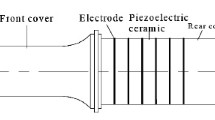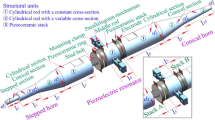Abstract
The transmitting models of ultrasonic vibration in ultrasonic transducer and capillary were presented according to the propagating mechanism of ultrasonic wave in elastic body. The coupling characteristics of ultrasonic longitudinal-complex transverse vibration system were simulated by Matlab software. The ultrasonic vibration displacement and the velocity of high frequency were measured by using the PSV-400-M2 (1.5 MHz) laser Doppler vibrometer. The vibration locus shapes driven by the same frequency and different frequencies were tested by using GDS-820S dual channel digital oscilloscope. The microstructures at bonding interface were observed by means of KYKY2800 scanning electron microscope. The results show that ultrasonic vibration displacement or velocity and energy density increase with the decrease of section area in the transmitting process. The vibration locus shapes driven simultaneously by the same frequency and different frequencies are elliptical (or circular) loci and rectangular (or square) loci, respectively. And the characteristics at bonding interface are improved by coupling loci.
Similar content being viewed by others
References
LIU Wen-jun. High density and high performance electronic packaging technology[J]. Electronic Packaging, 1998, 26(2): 1–14. (in Chinese)
Baliga J. Flip-chip packaging: prepare for the ramp-up [J]. Semiconductor International, 1998, 21(3): 87–94.
Kang S Y, Williams P M, Lee Y C. Modeling and experiment studies on thermosonic flip chip bonding [J]. IEEE Trans on Components, Packaging, and Manufacturing Technology (Part B), 1995, 18(4): 728–733.
Kleina M, Oppermannb H, Reichlb H. Single chip bum** and reliability for flip chip processes[J]. Microelectronics Reliability, 1999(39): 1389–1397.
LIAO Hua-li, LIU Ren-xiao. The study of the performance of vibration energy transmission in the ultrasonic amplitude transformer[J]. Machinery Design and Manufacture, 1999(5): 71–72. (in Chinese)
Mclaren T S, Kang S Y, Xhang W. Thermosonic bonding of an optical transvever based on 8×8 cavity surface emitting laser arrag[J]. IEEE Trans on Components, Packaging and Manufacturing Technology, 1997, 20(2): 152–160.
Kang S Y, William P M, Mclaren T S, et al. Studies on thermosonic bonding for flip-chip assembly[J]. Materials Chemistry and Physics, 1995, 42: 31–37.
Jiromaru T. Ultrasonic wire bonding using high frequency 330, 600 kHz and complex vibration 190 kHz welding systems[J]. Ultrasonics, 1996, 34(4): 223–228.
Tsu**o J, Yoshihara H, Sano T, et al. High-frequency ultrasonic wire bonding systems[J]. Ultrasonics, 2000, 38(5): 77–80.
Tsu**o J, Yoshihara H, Kamimoto K et al. Welding characteristics and temperature rise of high frequency and complex vibration ultrasonic wire bonding [J]. Ultrasonics, 1998, 36(2): 59–65.
Lum I, Jung J P, Zhou Y. Bonding mechanism in ultrasonic gold ball bonds on copper substrate[J]. Metallurgical and Materials Transactions, 2005, 36(1): 1279–1289.
Tsu**o J. Recent development of ultrasonic welding [A]. Proc IEEE 1995 Ultrasonics Symp[C]. New York: IEEE, 1996.
Tsu**o J, Hasagawa K, Sone Y, et al. Frequency characteristics of ultrasonic wire bonding using high frequency vibration systems of 40 kHz to 780 kHz [A]. Proc IEEE 1996 Ultrasonics Symp[C]. New York: IEEE, 1997.
Tsu**o J, Ueoka T. Vibration characteristics of one-dimensional longitudinal-torsional converter with multiple splitted parts[A]. Pro IEEE 1998 Ultrasonics Symp[C]. New York: IEEE, 1999.
Tsu**o J, Sano T, Ogata H, et al. Complex vibration ultrasonic welding systems with large area welding tips[J]. Ultrasonics, 2002, 30(40): 361–364.
LI Jun-hui, HAN Lei, ZHONG Jue. Interface structure of ultrasonic wedge bonding joints of Ni/Al[J]. Trans Nonferrous Met Soc China, 2005, 15(4): 846–850.
LI Jun-hui, TAN Jian-**, HAN Lei, et al. Studies on microstructure characteristics and evolutions at the bond interface in bonding technology[A]. IEEE Proceeding of HDP[C]. Shanghai, 2004.
LI Jun-hui, HAN Lei, ZHONG Jue. Atomic diffusion at the thermosonic bond interface in aluminum and gold and aluminum and nickel[A]. The 7th IEEE CPMT Conference on High Density Microsystem Design, Packaging and Failure Analysis(HDP05)[C]. Shanghai, 2005.
LI Jun-hui, HAN Lei, ZHONG Jue. Features of bonded interface and PZT transducer[A]. The 7th IEEE CPMT Conference on High Density Microsystem Design, Packaging and Failure Analysis(HDP05) [C]. Shanghai, 2005.
LI Jun-hui, HAN Lei, XHING jue. Microstructure characteristics at the thermosonic bond interface[J]. China Mechanical Engineering, 2005, 16(4): 341–344.
Author information
Authors and Affiliations
Corresponding author
Additional information
Foundation item: Project(50390064) supported by the National Natural Science Foundation of China
Rights and permissions
About this article
Cite this article
Li, Jh., Min, Sz., Han, L. et al. Characteristics of ultrasonic vibration transmission in bonding process. J Cent. South Univ. Technol. 12, 567–571 (2005). https://doi.org/10.1007/s11771-005-0124-8
Received:
Accepted:
Published:
Issue Date:
DOI: https://doi.org/10.1007/s11771-005-0124-8




